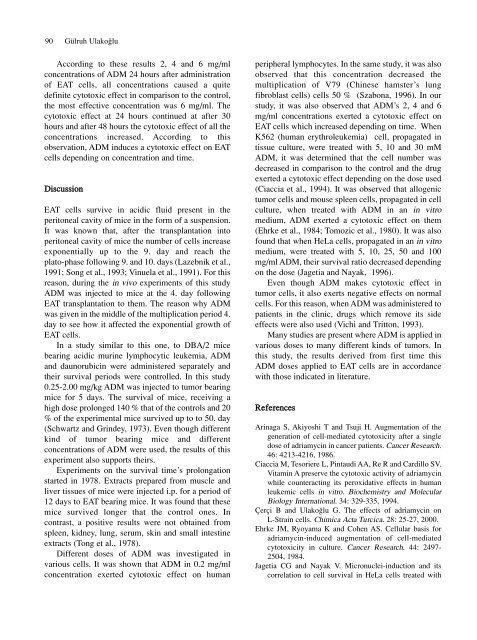Full Journal - Journal of Cell and Molecular Biology - Haliç Üniversitesi
Full Journal - Journal of Cell and Molecular Biology - Haliç Üniversitesi
Full Journal - Journal of Cell and Molecular Biology - Haliç Üniversitesi
You also want an ePaper? Increase the reach of your titles
YUMPU automatically turns print PDFs into web optimized ePapers that Google loves.
90 Gülruh Ulako¤lu<br />
According to these results 2, 4 <strong>and</strong> 6 mg/ml<br />
concentrations <strong>of</strong> ADM 24 hours after administration<br />
<strong>of</strong> EAT cells, all concentrations caused a quite<br />
definite cytotoxic effect in comparison to the control,<br />
the most effective concentration was 6 mg/ml. The<br />
cytotoxic effect at 24 hours continued at after 30<br />
hours <strong>and</strong> after 48 hours the cytotoxic effect <strong>of</strong> all the<br />
concentrations increased. According to this<br />
observation, ADM induces a cytotoxic effect on EAT<br />
cells depending on concentration <strong>and</strong> time.<br />
Discussion<br />
EAT cells survive in acidic fluid present in the<br />
peritoneal cavity <strong>of</strong> mice in the form <strong>of</strong> a suspension.<br />
It was known that, after the transplantation into<br />
peritoneal cavity <strong>of</strong> mice the number <strong>of</strong> cells increase<br />
exponentially up to the 9. day <strong>and</strong> reach the<br />
plato-phase following 9. <strong>and</strong> 10. days (Lazebnik et al.,<br />
1991; Song et al., 1993; Vinuela et al., 1991). For this<br />
reason, during the in vivo experiments <strong>of</strong> this study<br />
ADM was injected to mice at the 4. day following<br />
EAT transplantation to them. The reason why ADM<br />
was given in the middle <strong>of</strong> the multiplication period 4.<br />
day to see how it affected the exponential growth <strong>of</strong><br />
EAT cells.<br />
In a study similar to this one, to DBA/2 mice<br />
bearing acidic murine lymphocytic leukemia, ADM<br />
<strong>and</strong> daunorubicin were administered separately <strong>and</strong><br />
their survival periods were controlled. In this study<br />
0.25-2.00 mg/kg ADM was injected to tumor bearing<br />
mice for 5 days. The survival <strong>of</strong> mice, receiving a<br />
high dose prolonged 140 % that <strong>of</strong> the controls <strong>and</strong> 20<br />
% <strong>of</strong> the experimental mice survived up to to 50. day<br />
(Schwartz <strong>and</strong> Grindey, 1973). Even though different<br />
kind <strong>of</strong> tumor bearing mice <strong>and</strong> different<br />
concentrations <strong>of</strong> ADM were used, the results <strong>of</strong> this<br />
experiment also supports theirs.<br />
Experiments on the survival time’s prolongation<br />
started in 1978. Extracts prepared from muscle <strong>and</strong><br />
liver tissues <strong>of</strong> mice were injected i.p. for a period <strong>of</strong><br />
12 days to EAT bearing mice. It was found that these<br />
mice survived longer that the control ones. In<br />
contrast, a positive results were not obtained from<br />
spleen, kidney, lung, serum, skin <strong>and</strong> small intestine<br />
extracts (Tong et al., 1978).<br />
Different doses <strong>of</strong> ADM was investigated in<br />
various cells. It was shown that ADM in 0.2 mg/ml<br />
concentration exerted cytotoxic effect on human<br />
peripheral lymphocytes. In the same study, it was also<br />
observed that this concentration decreased the<br />
multiplication <strong>of</strong> V79 (Chinese hamster’s lung<br />
fibroblast cells) cells 50 % (Szabona, 1996). In our<br />
study, it was also observed that ADM’s 2, 4 <strong>and</strong> 6<br />
mg/ml concentrations exerted a cytotoxic effect on<br />
EAT cells which increased depending on time. When<br />
K562 (human erythroleukemia) cell, propagated in<br />
tissue culture, were treated with 5, 10 <strong>and</strong> 30 mM<br />
ADM, it was determined that the cell number was<br />
decreased in comparison to the control <strong>and</strong> the drug<br />
exerted a cytotoxic effect depending on the dose used<br />
(Ciaccia et al., 1994). It was observed that allogenic<br />
tumor cells <strong>and</strong> mouse spleen cells, propagated in cell<br />
culture, when treated with ADM in an in vitro<br />
medium, ADM exerted a cytotoxic effect on them<br />
(Ehrke et al., 1984; Tomozic et al., 1980). It was also<br />
found that when HeLa cells, propagated in an in vitro<br />
medium, were treated with 5, 10, 25, 50 <strong>and</strong> 100<br />
mg/ml ADM, their survival ratio decreased depending<br />
on the dose (Jagetia <strong>and</strong> Nayak, 1996).<br />
Even though ADM makes cytotoxic effect in<br />
tumor cells, it also exerts negative effects on normal<br />
cells. For this reason, when ADM was administered to<br />
patients in the clinic, drugs which remove its side<br />
effects were also used (Vichi <strong>and</strong> Tritton, 1993).<br />
Many studies are present where ADM is applied in<br />
various doses to many different kinds <strong>of</strong> tumors. In<br />
this study, the results derived from first time this<br />
ADM doses applied to EAT cells are in accordance<br />
with those indicated in literature.<br />
References<br />
Arinaga S, Akiyoshi T <strong>and</strong> Tsuji H. Augmentation <strong>of</strong> the<br />
generation <strong>of</strong> cell-mediated cytotoxicity after a single<br />
dose <strong>of</strong> adriamycin in cancer patients. Cancer Research.<br />
46: 4213-4216, 1986.<br />
Ciaccia M, Tesoriere L, Pintaudi AA, Re R <strong>and</strong> Cardillo SV.<br />
Vitamin A preserve the cytotoxic activity <strong>of</strong> adriamycin<br />
while counteracting its peroxidative effects in human<br />
leukemic cells in vitro. Biochemistry <strong>and</strong> <strong>Molecular</strong><br />
<strong>Biology</strong> International. 34: 329-335, 1994.<br />
Çerçi B <strong>and</strong> Ulako¤lu G. The effects <strong>of</strong> adriamycin on<br />
L-Strain cells. Chimica Acta Turcica. 28: 25-27, 2000.<br />
Ehrke JM, Ryoyama K <strong>and</strong> Cohen AS. <strong>Cell</strong>ular basis for<br />
adriamycin-induced augmentation <strong>of</strong> cell-mediated<br />
cytotoxicity in culture. Cancer Research. 44: 2497-<br />
2504, 1984.<br />
Jagetia CG <strong>and</strong> Nayak V. Micronuclei-induction <strong>and</strong> its<br />
correlation to cell survival in HeLa cells treated with

















